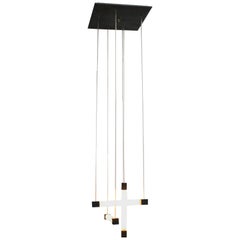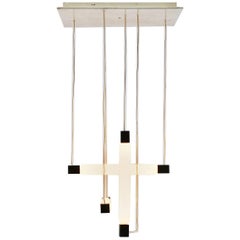Rietveld Buizenlamp
Recent Sales
Vintage 1960s Dutch De Stijl Chandeliers and Pendants
Metal
Vintage 1950s Dutch De Stijl Chandeliers and Pendants
Wood, Plywood, Glass
A Close Look at de-stijl Furniture
It has been more than 100 years since the founding of the Dutch art and design movement known as De Stijl.
It was in October of 1917 that artist, architect and critic Theo van Doesburg released the first issue of De Stijl magazine. A platform for artists, designers and architects to express their revolutionary new ideas, the journal was a launching point for what would become an international movement. Meaning “the Style,” De Stijl was an attempt at pure abstraction — one centered on the use of primary colors and perpendicular lines as a utopian expression of a harmonious world.
Along with van Doesburg, the group’s most integral members were Bart van der Leck, Gerrit Rietveld and Piet Mondrian, whose geometric red, yellow, blue and black “Composition” paintings remain the most recognizable work of the movement. Mondrian used the term “neoplasticism” to describe the abstract art that he and his friends produced.
Not just an art movement, however, De Stijl also had a profound impact on modern design and architecture. It would go on to influence Bauhaus and the International Style of architecture. Although it was disbanded in 1931, De Stijl continues to inspire the popular imagination today, and De Stijl creators and their ilk are responsible for timeless works (some of which can be found on 1stDibs).
Made from two plywood plates and 15 connecting bars, the Red and Blue chair is a calling card of the De Stijl movement. Designed by architect Gerrit Rietveld, the chair is most often referred to as the Rietveld chair, likely because it didn’t actually get its signature De Stijl colors until the early 1920s.
Also designed by Rietveld, this asymmetrical side table was constructed for his first residential commission, the Rietveld Schröder House in Utrecht, which is now a Unesco World Heritage Site.
Mondrian is the De Stijl group’s most well-known member. His familiar black lines with red, yellow and blue blocks are still reproduced in artworks and products today.
Russian-American artist Ilya Bolotowsky was highly interested in the work of Piet Mondrian. A founding member of the New York–based American Abstract Artists — other founders included Ray Kaiser (later Eames) and Josef Albers — Bolotowsky was smitten with Mondrian’s pure geometric abstractions from the period when lived in New York. In this signed, untitled silkscreen print from around 1970, you can see Bolotowsky’s use of hard-edge vertical and horizontal lines, as well as primary colors, although he didn’t limit himself to this palette.
Mondrian is the De Stijl group’s most well-known member. His familiar black lines with red, yellow and blue blocks are still reproduced in artworks and products today. In the 1960s, Yves Saint Laurent designed the Mondrian Collection of cocktail dresses. This wall mirror by Italian manufacturer Rimadesio is among the many decor pieces created in the likeness of Mondrian.
On 1stDibs, find De Stijl lighting, De Stijl decorative objects and more.
Finding the Right chandeliers-pendant-lights for You
Chandeliers — simple in form, inspired by candelabras and originally made of wood or iron — first made an appearance in early churches. For those wealthy enough to afford them for their homes in the medieval period, a chandelier's suspended lights likely exuded imminent danger, as lit candles served as the light source for fixtures of the era. Things have thankfully changed since then, and antique and vintage chandeliers and pendant lights are popular in many interiors today.
While gas lighting during the late 18th century represented an upgrade for chandeliers — and gas lamps would long inspire Danish architect and pioneering modernist lighting designer Poul Henningsen — it would eventually be replaced with the familiar electric lighting of today.
The key difference between a pendant light and a chandelier is that a pendant incorporates only a single bulb into its design. Don’t mistake this for simplicity, however. An Art Deco–styled homage to Sputnik from Murano glass artisans Giovanni Dalla Fina (note: there is more than one lighting fixture that shares its name with the iconic mid-century-era satellite — see Gino Sarfatti’s design too), with handcrafted decorative elements supported by a chrome frame, is just one stunning example of the elaborate engineering that can be incorporated into every component of a chandelier.
Chandeliers have evolved over time, but their classic elegance has remained unchanged. Not only will the right chandelier prove impressive in a given room, but it can also offer a certain sense of practicality. These fixtures can easily illuminate an entire space, while their elevated position prevents them from creating glare or straining one’s eyes. Certain materials, like glass, can complement naturally lit settings without stealing the show. Brass, on the other hand, can introduce an alluring, warm glow. While LEDs have earned a bad reputation for their perceived harsh bluish lights and a loss of brightness over their life span, the right design choices can help harness their lighting potential and create the perfect mood. A careful approach to lighting can transform your room into a peaceful and cozy nook, ideal for napping, reading or working.
For midsize spaces, a wall light or sconce can pull the room together and get the lighting job done. Perforated steel rings underneath five bands of handspun aluminum support a rich diffusion of light within Alvar Aalto's Beehive pendant light, but if you’re looking to brighten a more modest room, perhaps a minimalist solution is what you’re after. The mid-century modern furniture designer Charlotte Perriand devised her CP-1 wall lamps in the 1960s, in which a repositioning of sheet-metal plates can redirect light as needed.
The versatility and variability of these lighting staples mean that, when it comes to finding something like the perfect chandelier, you’ll never be left hanging. From the whimsical — like the work of Beau & Bien’s Sylvie Maréchal, frequently inspired by her dreams — to the classic beauty of Paul Ferrante's fixtures, there is a style for every room. With designs for pendant lights and chandeliers across eras, colors and materials, you’ll never run out of options to explore on 1stDibs.

